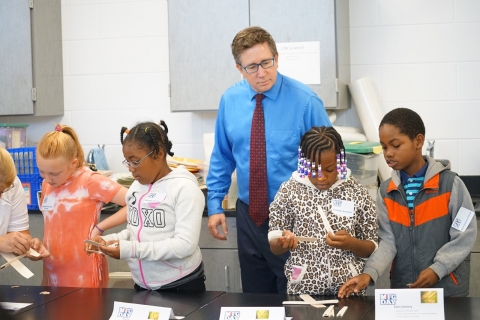Oct112016
Posted at 4:23 PM
Blog post by Patrick Ross, Chief Communications Officer for the U.S. Patent and Trademark Office
While touring five different manufacturing plants in greater Dayton, Ohio, last Friday on Manufacturing Day, I kept hearing the same response to my question of what a plant owner’s most pressing challenge is: “The only thing impeding our growth is a sufficient number of workers,” as Noble Tool President Jim Zahora said.
Dayton was hit hard by the economic downturn of eight years ago, but like many communities across the country, the region is rebounding. If you’ve flown on a plane lately or driven a car, it’s likely some of the parts conveying you were manufactured in Dayton, or that the machines engineered to make those parts came from Dayton. But while manufacturing jobs as a whole in the United States have increased by 3% since 2013, there are more jobs waiting for employees in Dayton.
And these jobs are not your father’s manufacturing jobs, if you will. A typical day in the life of a floor worker in a Dayton plant is, well, not typical. One day you might be welding a movable arm to a security robot. Another day you might be polishing the coating of what will become a half-ton truck’s grille. And as Rack Processing COO Jim Bowman pointed out, you might be designing your own unique tool to more effectively conduct that polishing.
But the need for employees goes beyond line work, noted Angelia Erbaugh, President of the Dayton Region Manufacturing Association. Software skills are needed to design machines and parts on computers. Electrical, mechanical, and chemical engineers drive that design process. And sales people and financial accountants bring in new business while maximizing plant efficiency, ensuring robust competition in wages and output with foreign manufacturers.
“Our focus is on ensuring the next generation of workers look seriously at manufacturing careers,” said Tim O’Meara, president of GEMCITY Engineering and Manufacturing. About 450 local high school students toured his factory over the course of the day, some of thousands at numerous facilities who saw career options before them—whether they attend college or not—that they may not have previously considered.
I was personally moved by the fourth-graders in a workshop at River’s Edge Montessori School. In the course of 10 minutes, the students in assembly-line fashion produced 18 balsa-wood gliders. Each student was assigned a role to play complete with job title. It was clear in their faces and demeanors that they engaged in the exercise with enthusiasm and pride. Mary Faulkner of the City of Dayton told me the program—done in partnership with the Dayton Metro Library and Wright Patterson Air Force Base—was intended to reach every single fourth-grader in Dayton.
After a whirlwind day of factory tours and interaction with local students, no one could cling to the myth that manufacturing is not alive and well in the United States. This proved especially clear to me in my last tour. Bastech has since the mid-1990s been engaged exclusively in additive manufacturing, known to most people as 3D printing. As owner Ben Staub took me through the facility, I was struck by how many different techniques are employed in this growing industry, and how many roles it can play in manufacturing, from developing prototypes for parts that would later be manufactured by more conventional means to the actual manufacturing of parts that could not possibly be produced with traditional drills and lathes. We think of 3D printing as the future, but it is very much part of the present in Dayton.
These manufacturers need workers of all backgrounds and levels of education. They provide these workers with solid wages and opportunities for rewarding work. In the last six years, there are 828,000 more Americans working in manufacturing but there’s room for many, many more.




